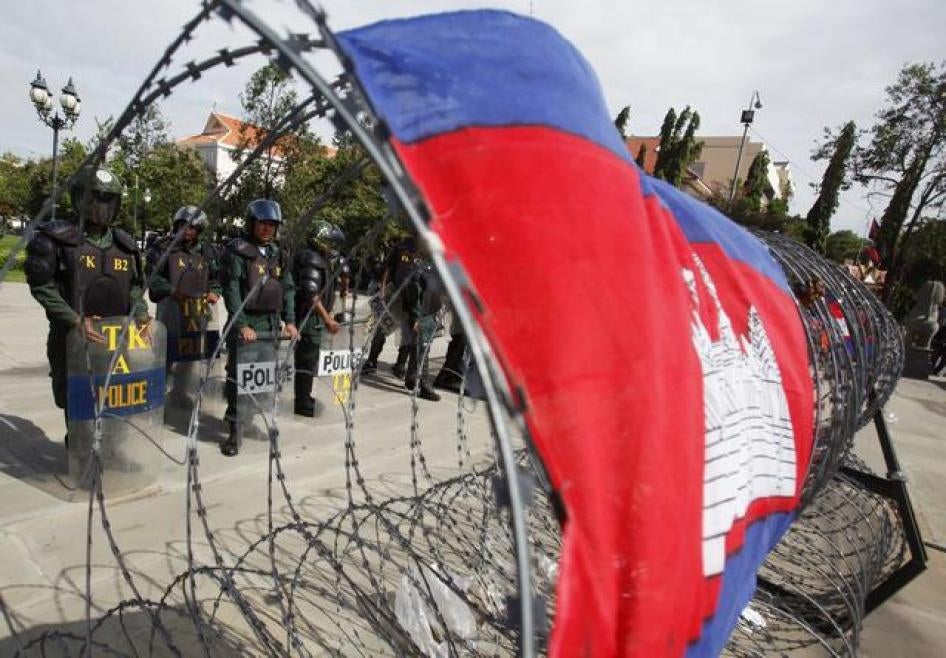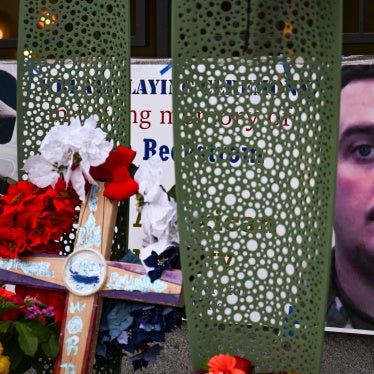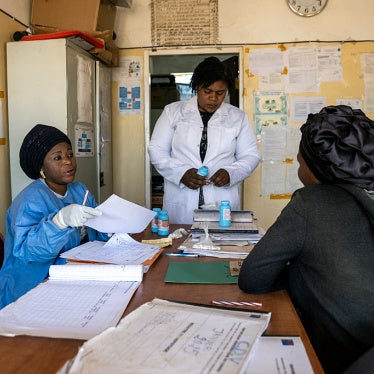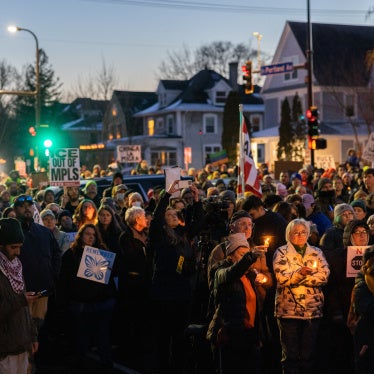“Eleven opposition activists received long sentences for a supposed insurrection that the court judgment shows never happened,” said Brad Adams, Asia director. “This case is a crucial test of judicial independence in Cambodia. So long as the men remain imprisoned, it’s because Prime Minister Hun Sen remains in control of Cambodia’s courts.”
The July 15, 2014 demonstration called for the reopening of Phnom Penh’s Democracy Plaza, known as Freedom Park, one in a series by the CNRP to protest government manipulation of the July 2013 elections and restrictions on peaceful assembly. The non-violent gathering deteriorated into a melee when para-police forcibly attempted to move the protesters, some of whom responded violently. CNRP activists, including several of the 11, tried to stop the violence. There were reported injuries to 41 para-police and 6 protesters, including 3 who were hurt when they attempted to protect security force members from attack.
Human Rights Watch closely reviewed the events of July 15, 2014 and the subsequent trial. The Phnom Penh Court’s July 21, 2015 judgment against the 11, discussed in detail below, shows that charges of “insurrection” were trumped up to obtain politically motivated convictions against opposition supporters. Several times Prime Minister Hun Sen threatened to file charges against CNRP National Assembly members who were initially arrested after the demonstration. The authorities did not prosecute any security force personnel implicated in violence and injuries inflicted on protesters.
The 11 men who were convicted and sentenced to 7 to 20 years in prison are Meach Sovannara, Oeu Narit, Khin Roeun, Neang Sokhun, San Kimheng, Sum Putthy, Ke Khim, Tep Narin, An Patham, San Seiha, and Uk Pechsamnang.
At the trial, no evidence proving the elements of the crime of insurrection was offered and no criminal intent was demonstrated by those convicted either of “leading” or “participating” in the alleged uprising. Under Cambodia’s Penal Code, those tried cannot have been found guilty on the basis of violence by others that may have resulted from supposed recklessness, carelessness, or negligence on the part of the convicted.
The trial court ignored audio and video evidence from the scene that supports allegations that the para-police initiated the violence, including use of batons and truncheons. The police break-up action was followed by several waves of crowd violence, despite calls by several defendants to remain peaceful, that resulted in injuries, some serious, to the para-police. In the court’s judgment, none of the injured para-police identified any of the 11 defendants as perpetrators of the violence.
“Embassies and United Nations agencies should call for a fair appeal process based on evidence, and send observers to the hearings,” Adams said. “They should not shy away from publicly condemning an unjust outcome.”
Analysis of the July 21, 2015 Judgment
The Phnom Penh Municipal Court began hearings in the case of the 11 Cambodia National Rescue Party Members on December 24, 2014. On July 20, the three trial judges suddenly announced they were going to expedite the proceedings and scheduled hearings for the next day, even though defense lawyers were unable to attend.
On July 21, with only one defense lawyer present, leaving many of the accused without legal representation, the trial judges allowed accusatory witness statements to be read into evidence without calling the people who had made them. They then directed that closing arguments be made immediately, overruling requests from the accused for a delay so all their lawyers would have time to prepare such statements.
The judges then retired to consider the case, as security forces massed in and around the courthouse. After 15 minutes, the judges returned to the courtroom and announced the guilty verdicts and sentences. All 11 defendants were found guilty and sentenced to from 7 to 20 years in prison for “insurrection.”
In its judgment of July 21, 2015 the court concluded there was an “insurrection” at Democracy Plaza on July 15, 2014. Three of those on trial (Meach Sovannara, Oeu Narit, and Khin Roeun) were found guilty of “leading” the insurrection, while the remaining eight (Neang Sokhun, San Kimheng, Sum Putthy, Ke Khim, Tep Narin, An Patham, San Seiha, and Uk Pechsamnang) were found guilty of participating in it.
In the judgment, the trial judges highlighted the connections of the 11 to the opposition CNRP, of which all but one were members, some holding elected local office, others having posts in the party’s national structure or leaders of the party’s youth organization in Phnom Penh.
Cambodian authorities had closed Democracy Plaza, a site designated by law as a venue for holding public protests, on January 4, 2014, as part of a violent security force crackdown on political party and trade union gatherings protesting electoral fraud and demanding higher wages. The crackdown was ordered by Prime Minister Hun Sen. Security forces firing on the outskirts of Phnom Penh in the previous days shot and killed five workers.
In the ensuing months, a number of elected members of parliament from the CNRP, which was then boycotting the National Assembly, led a series of small nonviolent demonstrations outside the security-force barricaded perimeter of Democracy Plaza, calling on the government to “free” it so protests there could resume. “Public order” para-police operating outside the barricades as the frontline contingent of the security forces repeatedly broke up these demonstrations, sometimes inflicting severe beatings on protesters and journalists covering events. After several CNRP members-elect of parliament announced a demonstration for July 15, 2014, a government spokesperson warned that if they went ahead security forces would “beat” them if they gathered. Despite this, hundreds of CNRP parliamentarians, grassroots organizers, supporters, and ordinary people assembled on the morning of July 15, where para-police once again conducted a break-up operation, which provoked crowd violence.
The Trial
In finding all 11 defendants guilty of insurrection that day, the trial court judgment ignored security force violence while concluding that violence against security force members constituted “collective violence.” It stressed that 41 members of the “public order” para-police and “people’s defense” forces were injured. These 41 participated in the case as victims, providing statements on which the trial judges relied in part for reaching their judgment. Nine of the 41 appeared as victims to answer questions in trial hearings. The statements of the remainder were read into the record in open court, but these para-police officers were not present to face defense questioning.
The judgment cited statements by a few members of the para-police injured at the scene that the demonstrators’ actions disrupted some traffic in the area of the demonstration and, much more importantly, that the accused leaders and participants intended to violently seize and occupy Democracy Plaza in defiance of the January 4, 2014 Ministry of Interior proclamation closing it to public use, reiterated in a Phnom Penh Capital letter of July 14, 2014.
The judgment ignored consistent statements by the accused and audio/video from the scene that the purpose of the demonstration was to gather to peacefully call on the government to reopen the park, according to the slogan “free (dah-leng) Democracy Plaza.” This was the slogan emblazoned on prepared banners that demonstrators brought to the scene and proclaimed in speeches and chanting by CNRP National Assembly members and demonstrators. No evidence was produced to show there was an effort by protesters to enter the barricaded area.
The judgment does not refute any of this, but appears to construe the slogan “Free Democracy Plaza” as revealing a hidden CNRP intention to violently storm and forcibly seize the plaza – thus evidence of a crime that was not successfully carried out as intended. In so doing, the judgment relied on statements by a few injured para-police that some unspecified demonstrators spoke about “liberating” (rumdah) the plaza, using a Khmer word that could be understood as a call for direct demonstrator action to free it from security force occupation. It also relied heavily on a single statement in a video clip in which a CNRP National Assembly member, Long Botta, spoke of the “necessity to liberate and take back Democracy Plaza.” This appears to be the main evidence for the judgment’s conclusion that an insurrection occurred under the “properly organized” leadership of the CNRP.
The trial court judgment repeatedly cites the presence at the demonstration of several CNRP members of parliament, including Mu Sochua, Hou Van, Riel Khemarin, and Keo Phirum. They are among seven CNRP parliamentarians (not including Long Botta) originally also detained and charged with insurrection in the same case. Following the earlier severing of the two cases, the seven are currently on temporary release, but a judicial investigation remains active to assess whether there is sufficient evidence to indict them, too, for trial. At times of political tension with the CNRP, Hun Sen has threatened on multiple occasions to charge these members of parliament.
The judgment does not cite evidence that any of the seven used the term “liberation,” but rather that Mu Sochua, in particular, had given instructions the day before that the demonstration should be conducted non-violently to call for the plaza to be freed, and that she and Riel Khemarin were instrumental in demonstrators’ placement of a banner on the barricades calling for the freeing of the plaza. It also appears to use the fact that Mu Sochua, Riel Khemarin, Ho Van, and Meach Sovannara made speeches at the scene calling for the plaza to be freed as evidence of leadership of an insurrection, even though these same speeches called on demonstrators to adhere strictly to non-violence. Seeming to attempt to support the proposition of a CNRP hidden agenda, the judgment maintains that at least some demonstrator violence was perpetrated more or less simultaneously with the speech-making. However, the audio/video evidence shows that CNRP calls for non-violence were made in an attempt to keep crowd members calm and to resist violent acts.
The judgment presented no specific evidence of Meach Sovannara’s leadership role beyond the fact that he spoke in favor of freeing of the plaza. It argued that Oeu Narit was a leader of the “insurrection” because, by his own admission, he was an “assistant” to CNRP National Assembly member Mu Sochua, and he personally wrote the banner with the slogan “Free Democracy Plaza.” The judgment referred to Oeu Narit’s advance writing of the banner in also concluding that he, Mu Sochua, and Meach Sovannara “truly intended to formulate a clear plan” to carry out an insurrection.
The judgment appears to contend that the demonstrators who were carrying plastic and wooden poles, to which flags and banners were attached, were in possession of “weapons.” Although no evidence is presented that demonstrators brought these poles to the park with intent to use them against the para-police, statements to the court by the latter and audio/video from the scene does show that once violence broke out, some demonstrators and perhaps bystanders assaulted para-police with poles, as well as with rocks, fists, and feet.
Without any evidence offered at trial, the judgment concluded that violence began as a result of the suspects’ premeditated plot to “liberate” the plaza. However, the statements of the para-police before and during the hearings were consistent in saying they were ordered to the perimeter of the plaza under the command of district and commune authorities to “break-up” any gathering and, after their arrival, to remove any banners the demonstrators had placed or might place on the barricades. By the para-police accounts, they first attempted to “break-up” the gathering and have the banners removed by instructing the demonstrators to disperse and take the banners down, but these instructions were generally ignored. The para-police said they then broke up the gathering while trying to remove any and all banners. They assert they were then attacked.
In this regard, one of the accused, San Kimheng, admitted during court hearings that he struck a para-policeman with his hand, and another, Ke Khim, stated before and during hearings that he had picked up a rock, but denied ever having thrown it. However, both maintained they were acting in self-defense or in preparation for doing so, and other accused similarly maintained that the initial crowd violence was a reaction to attacks by the para-police, after which the situation escalated into a brawl.
Legal Errors in the Trial Court Judgment
The Phnom Penh Court’s July 21, 2015 judgment declared that the guilt of Meach Sovannara, Oeu Narit, and Khin Roeun was established because they committed offenses that “have the elements” of leading an insurrection as punishable by Cambodian Criminal Code articles 456 and 459. The offenses of the eight other defendants “have the elements” of participation in the insurrection itself as punishable under article 456. Meach Sovannara, Oeu Narit, and Khin Roeun were also charged with participating in the insurrection they were accused of leading.
Article 456 of the Criminal Code defines the elements of “insurrection” as the commission of an act of collective violence that could lead to endangering of the institutions of the Kingdom of Cambodia or an adverse effect upon national territorial integrity.
The means of participation in insurrection are spelled out in article 457 as including, alternatively:
1) the construction of barricades across roads or defense works or the doing of any task with the objective of obstructing the activities of public forces;
2) the occupation of buildings or facilities by force or deceit;
3) the destruction of buildings or facilities;
4) ensuring the transport or provision of logistical support to insurrectionaries;
5) personally instigating the concentration of insurrectionaries;
6) the possession or bringing on the person of weapons, explosives, or ammunition of all kinds; or
7) the setting up of oneself in place of the legitimate authorities.
Article 459 criminalizes “leadership” of an insurrection.
The Penal Code makes leaders and participants guilty of insurrection if that is the intended consequence of their conduct, even if the actual insurrection does not – but only “could” – take place. Article 4 of the Criminal Code provides generally that:
There shall be no offense in the absence of an intent to commit it. However, where so provided by law, an offense may result from recklessness, carelessness, negligence, or failure to fulfil a specific obligation.
As article 457 does not provide for commission of insurrection by means of recklessness, carelessness, negligence, or failure to fulfil a specific obligation, an individual cannot be found guilty of leading or participating in an insurrection simply by having committed acts that had insurrection as consequence, such as by indirectly sparking a series of events leading to an insurrection. (Articles 456, 457, and 459 of Cambodia’s Criminal Code echo those of the Criminal Code of France, from which they are directly derived; see article 412-3, article 412-4, and article 412-6, respectively.)
To be guilty of insurrection, the court would have to find that, in addition to “collective violence,” the conduct of the accused fulfilled at least one of the two alternative additional elements of the crime of insurrection, either
1) endangering the institutions of the Kingdom of Cambodia or
2) adversely affecting the national territorial integrity of the Kingdom of Cambodia.
With regard to the first element, this would require more than simply endangering the physical safety of certain individual officials, employees, or agents of state institutions. Otherwise, any attacks on such people could be considered insurrection.
There was no evidence presented of danger to Cambodia’s institutions. The second element would require an attempt to divide Cambodia’s national territory. There was no evidence of such an attempt.
The judgment includes no evidence that those convicted used any of the means of conducting an insurrection, including the construction of barricades across roads or defense works; any effort to obstruct the activities of public forces; the occupation of buildings or facilities by force or deceit; or the destruction of buildings or facilities.
In sum, there is no factual or legal basis for charges of insurrection against the defendants.









